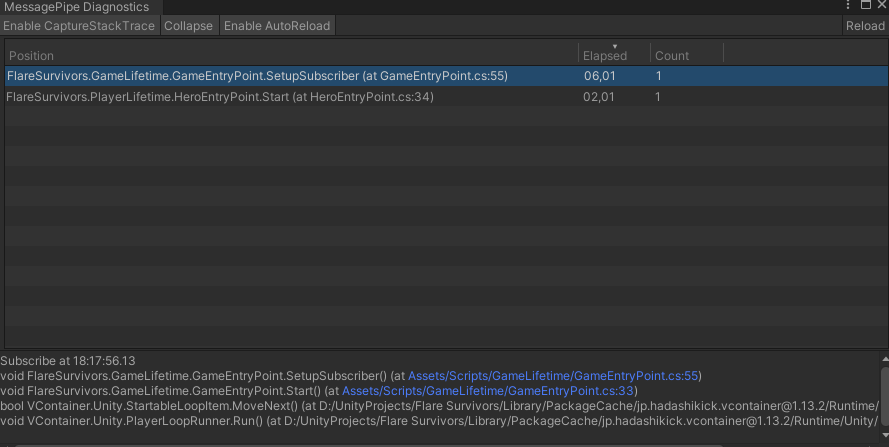More DI, FSM entry points and MessagePipe
This is part 2 of a series of articles about game architecture in Unity.
If you haven’t read part 1 yet, you can find it here.
As I was thinking about the next part of this series, I realized that having access to the full source code of the project would be a great way to illustrate the concepts I’m talking about… I cannot just share Bill’s source code, so I decided to create a new project, with a similar architecture, but with a different game : Flare Survivors so you can follow along and see the code in action here : clandais/flare-survivors. (Update 2025-03-21: I have since moved on to a new project)
Adding Messages to the Pipe
I was looking for a way to keep things decoupled and stumbled upon Cysharp/MessagePipe.
It was perfect as it was designed to be used with Dependency Injection and it was also compatible with VContainer and built on top of UniTask. MessagePipe promotes itself as a “high performance in-memory messaging pipeline for .NET and Unity”.
It also comes with a diagnostics window to keep track of who is subscribing to what !

MessagePipe’s Diagnostic Window
The integration of MessagePipe was pretty easy. It needs to be registered, in my case, in GameLifetimeScope.
public class GameLifetimeScope : LifetimeScope
{
protected override void Configure(IContainerBuilder builder)
{
RegisterMessagePipe(builder);
/* ... */
builder.RegisterEntryPoint<GameEntryPoint>();
}
private void RegisterMessagePipe(IContainerBuilder builder)
{
// Register MessagePipe
MessagePipeOptions options = builder.RegisterMessagePipe(
options =>
{
// Enable capture stack trace for diagnostics window
options.EnableCaptureStackTrace = true;
});
// Setup GlobalMessagePipe to enable diagnostics window and global function
builder.RegisterBuildCallback(
c => GlobalMessagePipe.SetProvider(c.AsServiceProvider()));
/* ... */
}
}GameEntryPoint as a Finite State Machine
I wanted the GameEntryPoint to handle the game state and that each game state handled its own logic.
On entering a new state, the previous one cleans its garbage and the new one initializes itself and loads its stuff.
In order to keep it simple for now, I went with a simple Finite State Machine.
/// <summary>
/// Base class for all states.
/// </summary>
public abstract class BaseState : IDisposable
{
public abstract void Enter();
public abstract void Tick();
public abstract void Exit();
public abstract void Dispose();
}
/// <summary>
/// Base class for all game states.
/// </summary>
public abstract class BaseGameState : BaseState
{
[Inject] protected IObjectResolver Resolver;
[Inject] protected SceneReferences SceneReferences;
[Inject] protected IAsyncRequestHandler<LoadSceneRequest, LoadSceneResponse> LoadSceneRequestHandler;
[Inject] protected CoroutineRunner CoroutineRunner;
public override void Dispose()
{
Resolver?.Dispose();
}
}The GameEntryPoint is responsible for handling the current state and switching to a new one.
public class GameEntryPoint :
IStartable,
ITickable,
IDisposable
{
// Inject the IObjectResolver to "find" the states
[Inject] private IObjectResolver _resolver;
// Inject the ISubscriber to listen to GameStateTransitionMessage
[Inject] private ISubscriber<GameStateTransitionMessage> _gameStateTransitionSubscriber;
// Here goes the garbage
private IDisposable _disposable;
// The current state (obviously)
private BaseGameState _currentState;
public void Start()
{
SetupSubscriber();
// Resolve the first state
_currentState = _resolver.Resolve<GameBootState>();
_currentState.Enter();
}
public void Tick()
{
// Tick the current state
_currentState.Tick();
}
// When a GameStateTransitionMessage is received, we exit the current state and enter the new one
private void OnGameStateTransition(GameStateTransitionMessage msg)
{
_currentState.Exit();
_currentState = msg.GameState;
_currentState.Enter();
}
// Setup the subscriber to listen to GameStateTransitionMessage
private void SetupSubscriber()
{
DisposableBagBuilder disposableBag = DisposableBag.CreateBuilder();
_gameStateTransitionSubscriber
.Subscribe(OnGameStateTransition)
.AddTo(disposableBag);
_disposable = disposableBag.Build();
}
// Clean the mess
public void Dispose()
{
_resolver?.Dispose();
_disposable?.Dispose();
}
}Here is an example of a state, the GameBootState.
public class GameBootState : BaseGameState
{
// Trying to use addressables
private AsyncOperationHandle<SceneInstance> _gameBootSceneHandle;
public override async void Enter()
{
LoadSceneResponse response = await LoadSceneRequestHandler.InvokeAsync(new LoadSceneRequest
{
SceneReference = SceneReferences.MainMenuScene,
});
// Poor error handling
if (!response.IsSuccess)
{
Debug.LogError("GameBootState failed to load GameScene.");
return;
}
_gameBootSceneHandle = response.Handle;
await _gameBootSceneHandle.Result.ActivateAsync();
}
public override void Tick() { }
public override async void Exit()
{
await Addressables.UnloadSceneAsync(_gameBootSceneHandle).ToUniTask(CoroutineRunner);
}
}MessagePipe in action
Pub / Sub
So, how does it work ?
In the above code sample, where do the LoadSceneRequest, LoadSceneResponse and GameStateTransitionMessage come from ?
It starts with creating messages for some data-sharing. Messages can be simple structs.
public struct GameStateTransitionMessage
{
public BaseGameState GameState { get; set; }
}To be able to Inject the ISubscriber<GameStateTransitionMessage> and IPublisher<GameStateTransitionMessage>, we need to register them in the GameLifetimeScope.
private void RegisterMessagePipe(IContainerBuilder builder)
{
/*
Register MessagePipe
*/
// ISubscriber and IPublisher are registered using RegisterMessageBroker
builder.RegisterMessageBroker<GameStateTransitionMessage>(options);
}I chose to make child lifetimeScopes Publish the GameStateTransitionMessage when they are done with their job.
Here is an example with the MainMenuEntryPoint (which “lives” in a child lifetimeScope: MainMenuLifetimeScope).
public class MainMenuEntryPoint : IStartable, IDisposable
{
[Inject] private MainMenuView _mainMenuView;
[Inject] private IPublisher<GameStateTransitionMessage> _gameStateTransitionPublisher;
[Inject] private IObjectResolver _resolver;
public void Start()
{
_mainMenuView.PlayButton.onClick.AddListener(OnPlayButtonClicked);
}
private void OnPlayButtonClicked()
{
_gameStateTransitionPublisher.Publish(new GameStateTransitionMessage()
{
GameState = _resolver.Resolve<GamePlayState>(),
});
}
public void Dispose()
{
_mainMenuView.PlayButton.onClick.RemoveListener(OnPlayButtonClicked);
_resolver?.Dispose();
}
}That’s a pretty bare main menu, but you get the idea.
When the PlayButton is clicked, the MainMenuEntryPoint publishes a GameStateTransitionMessage with the GamePlayState as the new state.
The GameEntryPoint is listening to GameStateTransitionMessage and will switch to the GamePlayState when it receives it.
The Mediator Pattern

The French word for “guitar pick”
The AsyncRequestHandler<LoadSceneRequest, LoadSceneResponse> works in a sligthly different way. It is a pattern called the “Mediator Pattern”.
LoadSceneRequest and LoadSceneResponse are simple structs, too.
public struct LoadSceneRequest
{
public SceneReference SceneReference { get; set; }
}
public struct LoadSceneResponse
{
public bool IsSuccess { get; set; }
// Using addressables, we need to keep track of the handle
public AsyncOperationHandle<SceneInstance> Handle { get; set; }
}
Then, we need to create a handler for the request.
public class SceneAssetAsyncLoadingHandler
: IAsyncRequestHandler<LoadSceneRequest, LoadSceneResponse>
{
// Extending the IAsyncRequestHandler interface
public async UniTask<LoadSceneResponse> InvokeAsync(LoadSceneRequest request, CancellationToken cancellationToken = new CancellationToken())
{
// load the scene
// get back the handle
// omit error handling :D
return new LoadSceneResponse
{
IsSuccess = true,
Handle = handle,
};
}
}Finally, we need to register the handler in the GameLifetimeScope.
// registration in GameLifetimeScope
private void RegisterMessagePipe(IContainerBuilder builder)
{
/*** Register MessagePipe ***/
// Register the AsyncRequestHandler
builder
.RegisterAsyncRequestHandler<
LoadSceneRequest,
LoadSceneResponse,
SceneAssetAsyncLoadingHandler>(options);
}Conclusion
I hope I haven’t bored you to death with this article. It was a bit heavy on code, but I think it was necessary to illustrate the concepts I wanted to talk about.
Next time, if there is a next time, I’d like to take a break from architecture and talk about something else. Maybe the AssetPostprocessor ?